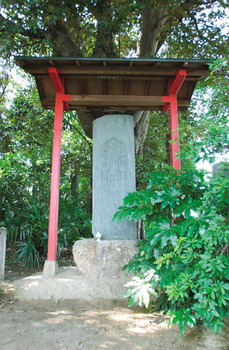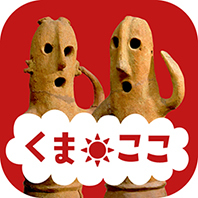令和3年度「地域観光資源の多言語解説整備支援事業」ー妻沼聖天山歓喜院 板石塔婆ー [その他]
Itabi Stone Tablet
板石塔婆

Itabi stone tablets were common across Japan from the thirteenth to sixteenth century. They were usually carved with Buddhist imagery and prayers to remind believers to stay on the true path of Buddhism. Most itabi in the Kanto region, including the one near Menuma Shodenzan Temple, were made from green chlorite schist, which was mined nearby in Chichibu and Ogawamachi, Saitama Prefecture.
The stone tablet at Menuma Shodenzan Temple is carved with an image of Amida, the Buddha of Infinite Light, flanked by Kannon, the bodhisattva of compassion, and Seishi, the bodhisattva of wisdom. The image is a reproduction of the Amida Triad of Zenkoji Temple in Nagano Prefecture, which was brought from India in the sixth century, and is believed to be one of the earliest Buddhist images brought to Japan. The central figure is surrounded by a halo of seven representations of Buddha.
The back of the stone is inscribed with the Sanskrit names of Shakyamuni (the historical Buddha), and his two attendants, the bodhisattvas Monju and Fugen. The stone tablet was likely carved during the Kamakura period (1185–1333). The tablet is 178 centimeters tall and 59 centimeters wide. It is a Tangible Cultural Property of Saitama Prefecture.
※この英語解説文は観光庁の地域観光資源の多言語解説整備支援事業で作成しました。

Itabi stone tablets were common across Japan from the thirteenth to sixteenth century. They were usually carved with Buddhist imagery and prayers to remind believers to stay on the true path of Buddhism. Most itabi in the Kanto region, including the one near Menuma Shodenzan Temple, were made from green chlorite schist, which was mined nearby in Chichibu and Ogawamachi, Saitama Prefecture.
The stone tablet at Menuma Shodenzan Temple is carved with an image of Amida, the Buddha of Infinite Light, flanked by Kannon, the bodhisattva of compassion, and Seishi, the bodhisattva of wisdom. The image is a reproduction of the Amida Triad of Zenkoji Temple in Nagano Prefecture, which was brought from India in the sixth century, and is believed to be one of the earliest Buddhist images brought to Japan. The central figure is surrounded by a halo of seven representations of Buddha.
The back of the stone is inscribed with the Sanskrit names of Shakyamuni (the historical Buddha), and his two attendants, the bodhisattvas Monju and Fugen. The stone tablet was likely carved during the Kamakura period (1185–1333). The tablet is 178 centimeters tall and 59 centimeters wide. It is a Tangible Cultural Property of Saitama Prefecture.
※この英語解説文は観光庁の地域観光資源の多言語解説整備支援事業で作成しました。






